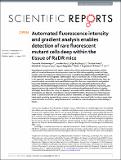Automated fluorescence intensity and gradient analysis enables detection of rare fluorescent mutant cells deep within the tissue of RaDR mice
Author(s)
Rajapakse, Jagath; Wadduwage, Dushan Nawoda; Kay, Jennifer Elizabeth; Singh, Vijay Raj; Kiraly, Orsolya; Sukup Jackson, Michelle Rae; Engelward, Bevin P; So, Peter T. C.; ... Show more Show less
Downloads41598-018-30557-9.pdf (3.889Mb)
PUBLISHER_CC
Publisher with Creative Commons License
Creative Commons Attribution
Terms of use
Metadata
Show full item recordAbstract
Homologous recombination (HR) events are key drivers of cancer-promoting mutations, and the ability to visualize these events in situ provides important information regarding mutant cell type, location, and clonal expansion. We have previously created the Rosa26 Direct Repeat (RaDR) mouse model wherein HR at an integrated substrate gives rise to a fluorescent cell. To fully leverage this in situ approach, we need better ways to quantify rare fluorescent cells deep within tissues. Here, we present a robust, automated event quantification algorithm that uses image intensity and gradient features to detect fluorescent cells in deep tissue specimens. To analyze the performance of our algorithm, we simulate fluorescence behavior in tissue using Monte Carlo methods. Importantly, this approach reduces the potential for bias in manual counting and enables quantification of samples with highly dense HR events. Using this approach, we measured the relative frequency of HR within a chromosome and between chromosomes and found that HR within a chromosome is more frequent, which is consistent with the close proximity of sister chromatids. Our approach is both objective and highly rapid, providing a powerful tool, not only to researchers interested in HR, but also to many other researchers who are similarly using fluorescence as a marker for understanding mammalian biology in tissues.
Date issued
2018-08Department
Massachusetts Institute of Technology. Department of Biological Engineering; Massachusetts Institute of Technology. Department of Mechanical EngineeringJournal
Scientific Reports
Publisher
Nature Publishing Group
Citation
Wadduwage, Dushan N. et al. “Automated Fluorescence Intensity and Gradient Analysis Enables Detection of Rare Fluorescent Mutant Cells Deep Within the Tissue of RaDR Mice.” Scientific Reports 8, 1 (August 2018): 12108
Version: Final published version
ISSN
2045-2322